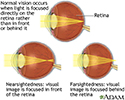Visual acuity test
Eye test - acuity; Vision test - acuity; Snellen test
The visual acuity test is used to determine the smallest letters you can read on a standardized chart (Snellen chart) or a card held 20 feet (6 meters) away. Special charts are used when testing at distances shorter than 20 feet (6 meters). Some Snellen charts are actually video monitors showing letters or images.
How the Test is Performed
This test may be done in a health care provider's office, a school, workplace, or elsewhere.
Visual acuity is usually recorded as:
- "Uncorrected," which is without glasses or contact lenses
- "Best corrected," which is with the best possible glasses or contact lens prescription
For uncorrected visual acuity, you will be asked to remove your glasses or contact lenses and stand or sit 20 feet (6 meters) from the eye chart. You will keep both eyes open.
You will be asked to cover one eye with the palm of your hand, a piece of paper, or a small paddle while you read out loud the smallest line of letters you can see on the chart. Numbers, lines, or pictures are used for people who cannot read, especially children. If you can't make out any of the letters, numbers, or pictures, the examiner will usually hold up some number of fingers and record at how many feet away you can correctly identify how many are being held up.
If you are not sure of the letter, you may guess. This test is done on each eye, and one at a time. If needed, it is repeated while you wear your glasses or contacts. You may also be asked to read letters or numbers from a card held 14 inches (36 centimeters) from your face. This will test your near vision.
How to Prepare for the Test
No special preparation is necessary for this test.
How the Test will Feel
There is no discomfort.
Why the Test is Performed
The visual acuity test is a routine part of an eye examination or general physical examination, particularly if there is a change in vision or a problem with vision.
In children, the test is performed to screen for vision problems. Vision problems in young children can often be corrected or improved. Undetected or untreated problems may lead to permanent vision damage.
There are other ways to check vision in very young children, or in people who do not know their letters or numbers.
Normal Results
Visual acuity is expressed as a fraction.
- The top number refers to the distance you stand from the chart. This is often 20 feet (6 meters).
- The bottom number indicates the distance at which a person with normal eyesight could read the same line you correctly read.
For example, 20/20 (6/6) is considered normal. 20/40 (6/12) indicates that the line you correctly read at 20 feet (6 meters) away can be read by a person with normal vision from 40 feet (12 meters) away.
Even if you miss one or two letters on the smallest line you can read, you are still considered to have vision equal to that line.
What Abnormal Results Mean
Abnormal results may be a sign that you need glasses or contacts. Or it may mean that you have an eye condition that needs further evaluation by a provider.
Risks
There are no risks with this test.
References
Chuck RS, Dunn SP, Flaxel CJ; American Academy of Ophthalmology Preferred Practice Pattern Committee, et al. Comprehensive adult medical eye evaluation preferred practice pattern. Ophthalmology. 2021;128(1):1-29. www.aaojournal.org/article/S0161-6420(20)31026-5/fulltext. Published November 12, 2020. Accessed March 2, 2021.
Olitsky SE, Marsh JD. Examination of the eye. In: Kliegman RM, St. Geme JW, Blum NJ, Shah SS, Tasker RC, Wilson KM, eds. Nelson Textbook of Pediatrics. 21st ed. Philadelphia, PA: Elsevier; 2020:chap 637.
Rubin GS. Visual acuity and contrast sensitivity. In: Schachat AP, Sadda SVR, Hinton DR, Wilkinson CP, Wiedemann P, eds. Ryan's Retina. 6th ed. Philadelphia, PA: Elsevier; 2018:chap 13.
Eye - illustration
Eye
illustration
Visual acuity test - illustration
Visual acuity test
illustration
Normal, nearsightedness, and farsightedness - illustration
Normal, nearsightedness, and farsightedness
illustration
Review Date: 3/2/2021
Reviewed By: Franklin W. Lusby, MD, Ophthalmologist, Lusby Vision Institute, La Jolla, CA. Also reviewed by David Zieve, MD, MHA, Medical Director, Brenda Conaway, Editorial Director, and the A.D.A.M. Editorial team.





